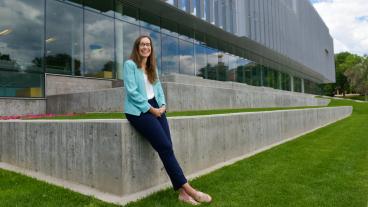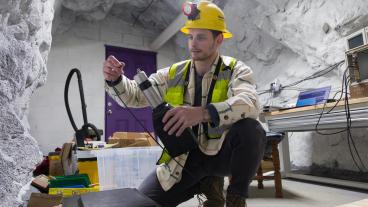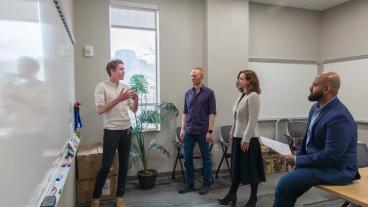
Alexander Gysi, assistant professor of lithogeochemistry in the Department of Geology and Geological Engineering at Colorado School of Mines, was recently awarded a National Science Foundation CAREER Award to further his work on rare earth elements.
His project, “Partitioning of Rare Earth Elements (REE) Between Minerals and Aqueous Fluids in Ore Deposits,” will receive $577,485 in funding over five years.
Gysi joined the Mines faculty in August 2014. He holds a PhD in geochemistry from the University of Iceland and M.S. in mineralogy and petrology from ETH Zurich.
We asked Gysi about his research and how it could help improve our understanding of fluid-rock interaction and ore-forming processes in geological systems.
Q: What is your latest research focused on?
A: "The research is on rare earth elements (REE) – the lanthanides, plus yttrium and scandium. Why these elements are interesting is because they’re considered critical metals. They are used in the high-tech and green technology industries, in permanent magnets, wind turbines, renewable energies, computers and cell phones. What I am trying to do is to further our understanding of how these REE deposits form in geological systems. At the same time, we are trying to push the boundaries of fundamental research in this field that will allow us to read the signatures recorded in minerals formed from hydrothermal fluids. The key question is what does the chemistry of minerals tell us about geological processes?"
Q: What do you find most exciting about your research?
A: "This research involves a lot of interdisciplinary work and has a high potential to make new discoveries. For many decades, REE have been measured in rocks to describe the evolution of melts from the mantle up to the Earth’s crust. Everyone assumed that fluids in the crust could not modify these signatures. But when we started working on the REE deposits, we realized that there is a lot of alteration of the rocks and that fluids actually play a crucial role in the formation of these deposits. Hydrothermal veins give us a snapshot of these crustal fluids, and their minerals can be used to read what has been going on in the geologic past deeper in the crust at elevated temperature and pressure. The veins you find when you go out into the Front Range, some of them in historic mining districts, consist mainly of quartz, but in REE deposits we find minerals such as calcite, apatite and fluorite. It is exciting to study these minerals because they form in variety of geologic environments, even on the Earth’s surface, in the ocean, etc. Some of them, such as apatite, are found in our bones and teeth, and their REE compositions are studied in medicine for example to image body tissues.
"What we’re doing in the lab is growing these minerals and doping them with REE to see how they behave. Then we’re trying to develop a new model to predict the meaning of these REE signatures in natural minerals. This is ambitious as we do not yet have a way to quantify the meaning of these REE signatures and to my knowledge, there are not many people who grow these minerals from hydrothermal solutions at >100 °C – it’s not easy to do but fun!
"My PhD student just graduated and I have two new PhD students who are just starting on this project. We are writing the first paper on the REE-doped calcite synthesized at 200 degrees Celsius and we are now the first research group who can model the trace element variations recorded in hydrothermal calcite using a geochemical modeling software. This work is new and is the starting point of years of research."
Q: What is the potential impact of this work?
A: "It touches a lot of different disciplines – material sciences, chemistry, geosciences, economic geology, petrology, etc. This is why I'm quite excited about it – we’re trying to bring different disciplines together and work at different scales from the behavior of atoms in the lab and models to hundreds of meters and kilometers in ore-forming geologic environments. It’s interesting too for the U.S. because China is producing most of the world’s REE supply – China controls over 90-95 percent of the global REE market. Recently, we’ve been thinking more about these mineral resources in North America, including Canada and the U.S. In the U.S., we have currently one mine in Mountain Pass, California, that was open and then closed and now reopened, and other potential mines such Bear Lodge in Wyoming.
"Potentially, if we start mining and exploring more of these deposits in the U.S., our research will provide the basic framework to understand where these deposits form, how to explore them, and how to characterize them. To give you an analogy, the exploration and mining industry for metals like copper, lead, zinc, silver and gold are currently in a Formula 1 car, relying on years of research in this area by many groups worldwide, whereas the REE industry is in a tricycle, trying to catch up when there is a market wave. We don’t know how the market and technology is going to evolve in the next few decades, but as scientists, it is essential to be forward looking and work with the industry."
Q: How does this research agenda inform your teaching?
A: "In geosciences, thermodynamics is a very powerful tool to interpret field data and geologic hypotheses and understand how and under which conditions rocks and minerals form. Unfortunately, this knowledge is dying out a little bit in the U.S. and I see a great opportunity to link traditional field geology to numerical models and technology for data analysis. Because of this, I developed a new undergraduate course “Thermodynamics for Geoscientists” and this semester I am planning to start writing a booklet to make this knowledge available to undergraduate students worldwide. The key is to make this science practical and easy to understand so the students get hooked and understand the importance of thermodynamics in geosciences.
"I have been now at Mines five years, and from this experience I see that undergraduate students would benefit from more research experience, to learn about methods used to solve problems in geosciences and to help find a job or continue their career in science. What I plan to do is a Fluids & Minerals Summer School, where we combine field work with lab work and try to model how an ore deposit actually forms. The idea is to visit an ore deposit in the field and study the hydrothermal veins that are actually conduits where fluids carry the metals that become later mineralized in the deposit. Then we will do some hands-on activities in the lab, where we learn to synthesize and measure the properties of minerals and fluids. The last part will be to link the field observations and the analytical part, so the students learn how to build a conceptual model describing ore-forming processes and how to use this knowledge in the field."




